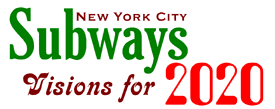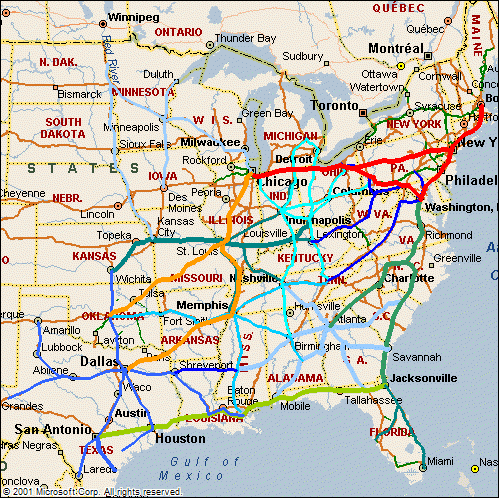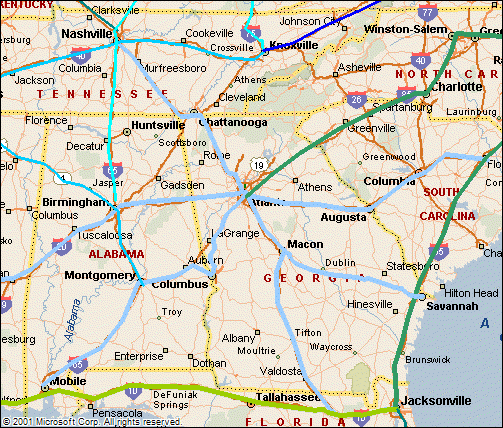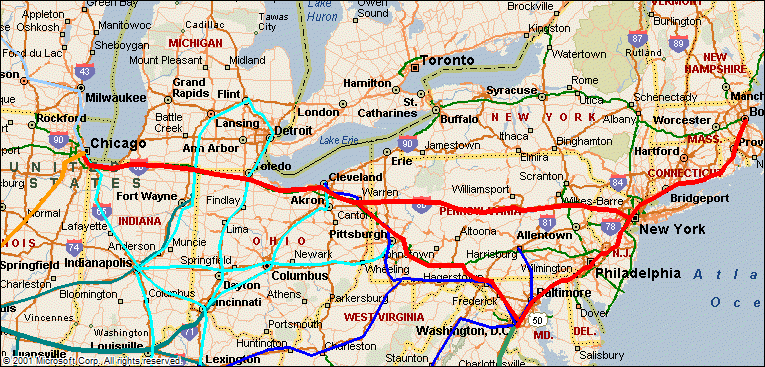
Life After AMTRAK

| Perhaps AMTRAK should not be saved and bailed out again. Maybe the time has come to rid ourselves of a system tied to existing freight lines, constrained by freight schedules and problems. Maybe it is time to go where no train has gone before! Before anything new can happen, Amtrak must fail and be destroyed.
I would not sell off its parts to private companies. Enron and others like it have shown such speculative ventures dealing in smoke and mirrors to be the risky schemes that they are. National transportation alternatives are far to important to allow them into private hands such as those, and it would be only such risky schemes that would put forth a bid on Amtrak properties. Far better be it that the existing local operating authorities take over passenger operations in their areas. For example NJT, the PA, Metro North, and others are proven transportation providers specializing in rail transportation and government and public relations. Let these Authorities take over what is left of Amtrak. What should be born to take the place of Amtrak? You could call it a "National Railroad System" but actually it is no such thing. It is a collection of regional High Speed Rail operating authorities, with regional and national operations owned and operated by a consortium of these regional operating authorities. Moving off of the freight lines! Much of Amtrak's problems is that it shares 1800s technologies on 1800s vintage railroad infrastructure. High speed rail is a joke as long as it has to run on 1800s freight alignments. Another part of Amtrak's current woes is that it is tied to Federal purse strings, and becomes a target and lightening rod for unreasonable expectations and self-serving policies. The subsidy of transportation systems is found in all modes of transport, yet Amtrak is expected to make money. It cannot. Yet some "authority" or government needs to grab the bull by the horns and do something to improve transportation. We are travelling more and more and more airplanes and airports are not an answer. The answer lies in many modes that must work together. Since these new High Speed Rail lines would be run state and regional authorities, an abundance of appropriate rights of way already exist: The new routes would be built along the existing interstate rights of ways. And so I have drawn a system built around the premise of several state or regional hubs. And these hubs are: These state and Regional Feeder Lines (shown on the map in various shades of blue) might be single track or double track, and might run on headways as short as 30 minutes, or as long as 3 hours. Lines would be in the 300 mile range in length. Speeds are in the 150 mph range. Consists are non-reserved coach class, perhaps with some sort of baggage check in service, with cafe and lounge cars available. Regional Trunk Lines (shown on the map in various shades of green) might be single or double track, and would run on headways of 30 to 120 minutes. Lines might be as long as 800 miles, speeds in the 200 mph range. Consists are both reserved (first class) and non-reserved coach accommodations, with dining cars as well as lounge cafe cars. Sleeper cars may be added to some trains. Regional Trunk Lines may be owned and operated by a single state or regional operating authority, or by a consortium of several such operating authorities. National Trunk Lines (shown on the map in red or orange) are double tracked and would run on headways of 30 to 60 minutes at speeds in excess of 200 mph. Alternate technologies might be sought (such as Mag-Lev?) That might bring speeds closer to 300 mph. (Since I envision these as the last lines to be created, I see time for some work on this technology) National trunk Lines might be owned an operated by a consortium of state and regional operating authorities, or might be operated by a federal authority ala Amtrak. There is no reason for these lines to be built at the same time as if it were to be a unified "system". It is not. There is no reason why equipment needs to be interchangeable. It is supposed to be a system that grows, just as the Interstate Highway System did. It would sure be nice if Federal Funding were made available to develop these routes on the same basis as Interstate Highway funds are made available to the various states. It might be nice if there were standards for this system, just as their are standards for the Interstate system. I believe that these standards need to be made by a consortium of operating authorities rather than by the federal government, although I have no basic objection to the DOT having a seat at the table. |
A Regional Operating Authority

| Taking a look at what a typical Regional Operating Authority might look like, here is a close up of Atlanta. This authority is running lines from Savannah and Jacksonville FL on single track ROWs to Macon, and then on dual tracks to Atlanta.
There is an interstate run to Mobile AL that makes a little dog-leg to pick up Columbus GA (the interstate by-passes the Columbus which in the highway scheme of things is served by a spur.) A regional line out of Memphis can be seen serving Montgomery, and another from Indianapolis serving Birmingham. There is another Interstate run headed for New Orleans LA via Birmingham, and the last Regional Feeder Line runs to Memphis. Of all the lines shown only this last might be two tracks the whole way. There is a Regional Trunk line leaving Atlanta for Charlotte NC and Washington DC. There is also a Regional Trunk between Washington and Jacksonville, and between Jacksonville and San Antonio. |
The National Operating Authority

| Some routes might be run on a national scope. Shown above in red is a system serving NYP-CHI; WAS-CHI; and WAS-NYP-BOS. All lines are dual tracked, all lines run or a 30 or 60 minute headway. Lines have fewer intermediate stops than the Regional Trunks would have. All seats are reserved. The NYP-CHI line is just over 700 miles long, and a train running at 200 mph could make the run (including intermediate stops) in about 4 hours.
Beyond Amtrak! The orange line shows a similar service between Chicago and Dallas or Oklahoma City. I have not drawn what the whole system might look like. The West Coast is still too far away for fast rail travel between the coasts. For this reason, these lines not only interface with themselves, but are proposed to be inter modal in nature, Arriving at a hub, such as Atlanta not only allows for connections to the Regional Trunk Line, but it is also an air hub, and can connect to services across the country, or even across the world. It is also seen that there is profit in services other than just passengers. Front-end business is not to be ignored. Mail, package express and other services need to be provided. Light-weight containerized material can move between rail, road, and air, and do so effortlessly and quickly. With a system such as this there is no reason for mail to touch an airplane anywhere east of the Mississippi. There are a few cross country trains, that while I ride on them, really do not fit the picture of efficient transportation. What could happen here is that someone (perhaps cruise ship lines) might offer cross country cruises. All accommodations are in sleepers, there is a dinning car, lounge and day cars. These trains operate outside of a tariffed system, that is not as a public carrier, but as a private system. They would contract with the freight railroads to pull their trains. There are layovers at points of interest and 'ports of call' for side tours. Such trains would not pick up passengers every hundred miles or so, but rather at every 'port of call'. Such 'cruises' can be pulled by the freight carriers the way that they would handle any charter. Arrival times might be specified as "Monday Morning" instead of 1043. All of this can happen. But Amtrak must die first. |